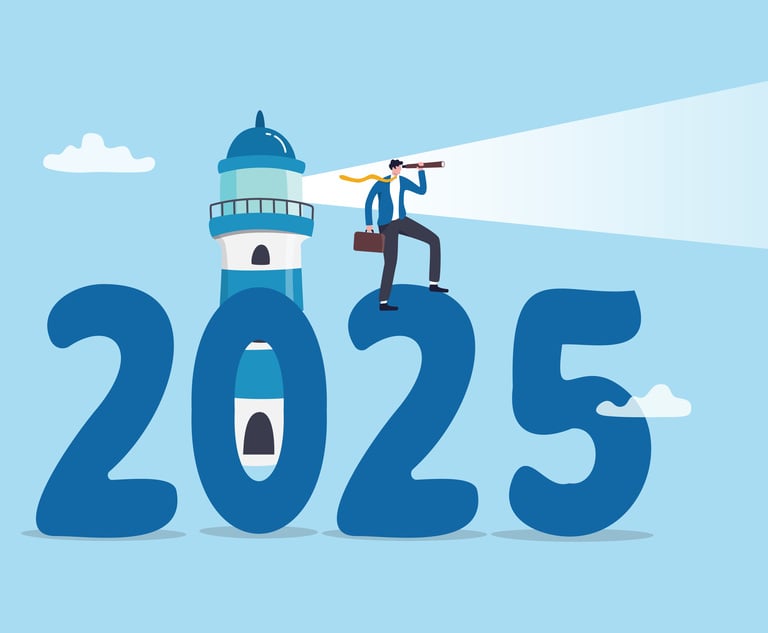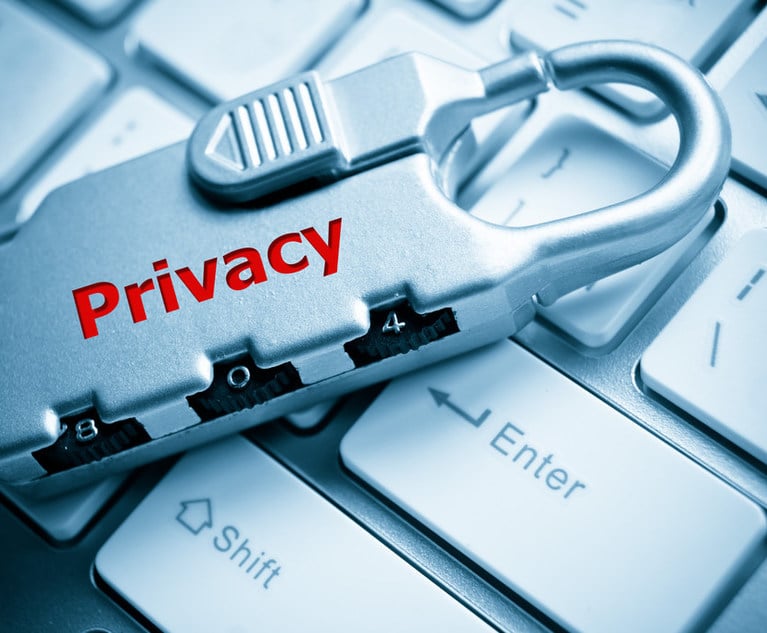Cybersecurity: A Combination of Legal, Business and Technical Measures
Following the development of internet technology and application, both legal and business options for eliminating or ameliorating cybersecurity difficulties have sprung into existence.
October 25, 2019 at 02:00 PM
6 minute read

Cybersecurity, the protection of computer hardware, software and data from the theft, damage, disruption and/or misuse, has been in place for decades. Due to the internet's connection to things like medical devices, personal devices and cars, cybersecurity is now relevant to individuals, whereas in the past only computer system manufacturers and operators needed to be cybersecurity savvy. Fortunately, legal, business and technical cybersecurity means are available to individuals and computer system manufacturers and operators alike.
Since 1988, when a self-replicating worm software allowed a Cornell graduate student to unintentionally disrupt up to 10% of all internet computers within a few hours (see United States v. Morris, 928 F.2d 504 (1991)), an industry specializing in technology solutions to cybersecurity matters has arisen. Following the development of internet technology and application, both legal and business options for eliminating or ameliorating cybersecurity difficulties have sprung into existence.
Despite the widespread use of legal, business and technical cybersecurity solutions that were designed to help prevent cyberattacks, data breaches and identity theft, the number and scope of internet security related difficulties are on the rise. The 2018 Internet Crime Report of the FBI's Internet Crime Complaint Center includes information from 351,936 complaints, which is an increase of 17% as compared to 2017, and 31% as compared to 2014.
Both criminal and civil legal options are available for dealing with cybersecurity matters. Several federal laws are applicable to resolving cybersecurity difficulties. These statutes are sector specific, namely, health, financial and governmental. Each of these three sectors has specific minimum cybersecurity rules they must follow.
The first federal law which specifically dealt with cybersecurity matters was the Health Insurance Portability and Accountability Act of 1996 (HIPAA) (see 42 U.S.C. § 1320d-6 (2018)). HIPAA's Privacy Rule includes "health plans, health care clearinghouses, and … health care provider[s] who transmit health information in electronic form in connection with transactions for which the Secretary of HHS has adopted standards under HIPAA." Significant civil and criminal penalties have continuously been assessed for failure to abide by the administrative safeguards, which include policies and procedures directives, and physical technical safeguard prerequisites.
The second federal law which specifically dealt with cybersecurity matters was the Gramm-Leach-Bliley Act of 1999 (GLB). GLB was applicable to banking, insurance and investment entities. Specifically, GLB includes regulations that require said entities to use the internet for collection, storage, protection and disclosure of customers' financial information. More specifically, 16 CFR Part 314 (Safeguards Rule) requires financial institutions under FTC jurisdiction to have measures in place to keep customer information secure. In addition to developing their own safeguards, companies covered by the Rule are responsible for taking steps to ensure that their affiliates and service providers safeguard customer information in their care.
The third federal law that specifically dealt with cybersecurity matters was the Federal Information Security Management Act of 2002 (FISMA). FISMA covers federal agencies and requires each federal agency to develop, document and implement specific cybersecurity programs.
States have also enacted cybersecurity minimum requirements for specific sectors, particularly financial institutions. For example, NY COMP. CODES Title 23, Section 500.01(c) (2019), requires specific minimum cybersecurity measures for New York person operating under or required to operate under a license, registration, charter, certificate, permit, accreditation or similar authorization under the Banking Law, the Insurance Law or the Financial Services Law.
While federal and state laws in conjunction with technical efforts by individuals and computer system manufactures and operators alike may have prevented or ameliorated the difficulties related to breaches in cybersecurity, both the scope and severity of cybersecurity breaches have increasingly interrupted revenue generating activities and often produce adverse publicity. Additionally, enforcement actions against businesses that have allegedly failed to adequately protect their internet assets, such as customer data, have resulted in legal difficulties and fines.
Consequently, the purchase of an insurance policy against cyberattack-related losses is another measure which is part of many entities' cybersecurity. Such a policy will cover damages to the insured and to third parties. Depending upon the policy, it may also cover the cost of attorney fees to defend damage claims. Typically, the insurer will require specific technological precautions to minimize insured losses from failure in an entity's cybersecurity.
Typically, the technology measures that insurers require are already employed by individuals and organizations. These measures usually include a properly configured and monitored firewall and regular review of firewall logs. More advanced precautions include automated intrusion detection systems, file integrity monitoring, and penetration testing.
In addition to learning how to recognize phishing attacks and what to do if a cybersecurity difficulty is detected, normally individuals will want to do the following to ensure the viability of their cybersecurity:
- Keep firewall on because it helps to protect your computer from hackers who might try to gain access to crash it, delete information, or even steal passwords or other sensitive information; and
- Install and maintain antivirus software because it is designed to prevent and neutralize malicious software programs as well as stopping third parties from collecting information without consent.
Finally, an individual can take a few steps to promote cybersecurity. Do not open an e-mail attachment from an unknown source. Only use trusted sites when providing your personal information. A good rule of thumb is to check the URL. If the site includes "https://," then it's a secure site. If the URL includes "http://," — note the missing "s" — avoid entering sensitive information like your credit card data or Social Security number. Setup Two Factor Authentication (2FA) which is In addition to a password; 2FA requires you to provide a second piece of information to confirm your identity. Don't use the same password for your personal and work emails. And last, turn off computers that are not in use. A computer that is off is generally free from being harmed or doing harm to others.
Jonathan D. Bick is Chair of the Patent, Intellectual Property, and Information Technology Practice at Brach Eichler LLC, in Roseland. He is a registered patent attorney and a frequent author and lecturer on the subjects of patents, intellectual property, and the internet. Sharoon Mark, a technical support specialist at the firm, contributed to the content of this article.
This content has been archived. It is available through our partners, LexisNexis® and Bloomberg Law.
To view this content, please continue to their sites.
Not a Lexis Subscriber?
Subscribe Now
Not a Bloomberg Law Subscriber?
Subscribe Now
NOT FOR REPRINT
© 2025 ALM Global, LLC, All Rights Reserved. Request academic re-use from www.copyright.com. All other uses, submit a request to [email protected]. For more information visit Asset & Logo Licensing.
You Might Like
View All

Amazon's Audible Hit With Privacy Class Action Over Use of Tracking Pixels


TikTok Hit With Class Action Claiming It Circumvented Age Verification Measures and Monetized Children's Data
4 minute readTrending Stories
- 16-48. It’s Comp Time Again: How To Crush Your Comp Memo
- 2'Religious Discrimination'?: 4th Circuit Revives Challenge to Employer Vaccine Mandate
- 3Fight Over Amicus-Funding Disclosure Surfaces in Google Play Appeal
- 4The Power of Student Prior Knowledge in Legal Education
- 5Chicago Cubs' IP Claim to Continue Against Wrigley View Rooftop, Judge Rules
Who Got The Work
Michael G. Bongiorno, Andrew Scott Dulberg and Elizabeth E. Driscoll from Wilmer Cutler Pickering Hale and Dorr have stepped in to represent Symbotic Inc., an A.I.-enabled technology platform that focuses on increasing supply chain efficiency, and other defendants in a pending shareholder derivative lawsuit. The case, filed Oct. 2 in Massachusetts District Court by the Brown Law Firm on behalf of Stephen Austen, accuses certain officers and directors of misleading investors in regard to Symbotic's potential for margin growth by failing to disclose that the company was not equipped to timely deploy its systems or manage expenses through project delays. The case, assigned to U.S. District Judge Nathaniel M. Gorton, is 1:24-cv-12522, Austen v. Cohen et al.
Who Got The Work
Edmund Polubinski and Marie Killmond of Davis Polk & Wardwell have entered appearances for data platform software development company MongoDB and other defendants in a pending shareholder derivative lawsuit. The action, filed Oct. 7 in New York Southern District Court by the Brown Law Firm, accuses the company's directors and/or officers of falsely expressing confidence in the company’s restructuring of its sales incentive plan and downplaying the severity of decreases in its upfront commitments. The case is 1:24-cv-07594, Roy v. Ittycheria et al.
Who Got The Work
Amy O. Bruchs and Kurt F. Ellison of Michael Best & Friedrich have entered appearances for Epic Systems Corp. in a pending employment discrimination lawsuit. The suit was filed Sept. 7 in Wisconsin Western District Court by Levine Eisberner LLC and Siri & Glimstad on behalf of a project manager who claims that he was wrongfully terminated after applying for a religious exemption to the defendant's COVID-19 vaccine mandate. The case, assigned to U.S. Magistrate Judge Anita Marie Boor, is 3:24-cv-00630, Secker, Nathan v. Epic Systems Corporation.
Who Got The Work
David X. Sullivan, Thomas J. Finn and Gregory A. Hall from McCarter & English have entered appearances for Sunrun Installation Services in a pending civil rights lawsuit. The complaint was filed Sept. 4 in Connecticut District Court by attorney Robert M. Berke on behalf of former employee George Edward Steins, who was arrested and charged with employing an unregistered home improvement salesperson. The complaint alleges that had Sunrun informed the Connecticut Department of Consumer Protection that the plaintiff's employment had ended in 2017 and that he no longer held Sunrun's home improvement contractor license, he would not have been hit with charges, which were dismissed in May 2024. The case, assigned to U.S. District Judge Jeffrey A. Meyer, is 3:24-cv-01423, Steins v. Sunrun, Inc. et al.
Who Got The Work
Greenberg Traurig shareholder Joshua L. Raskin has entered an appearance for boohoo.com UK Ltd. in a pending patent infringement lawsuit. The suit, filed Sept. 3 in Texas Eastern District Court by Rozier Hardt McDonough on behalf of Alto Dynamics, asserts five patents related to an online shopping platform. The case, assigned to U.S. District Judge Rodney Gilstrap, is 2:24-cv-00719, Alto Dynamics, LLC v. boohoo.com UK Limited.
Featured Firms
Law Offices of Gary Martin Hays & Associates, P.C.
(470) 294-1674
Law Offices of Mark E. Salomone
(857) 444-6468
Smith & Hassler
(713) 739-1250






